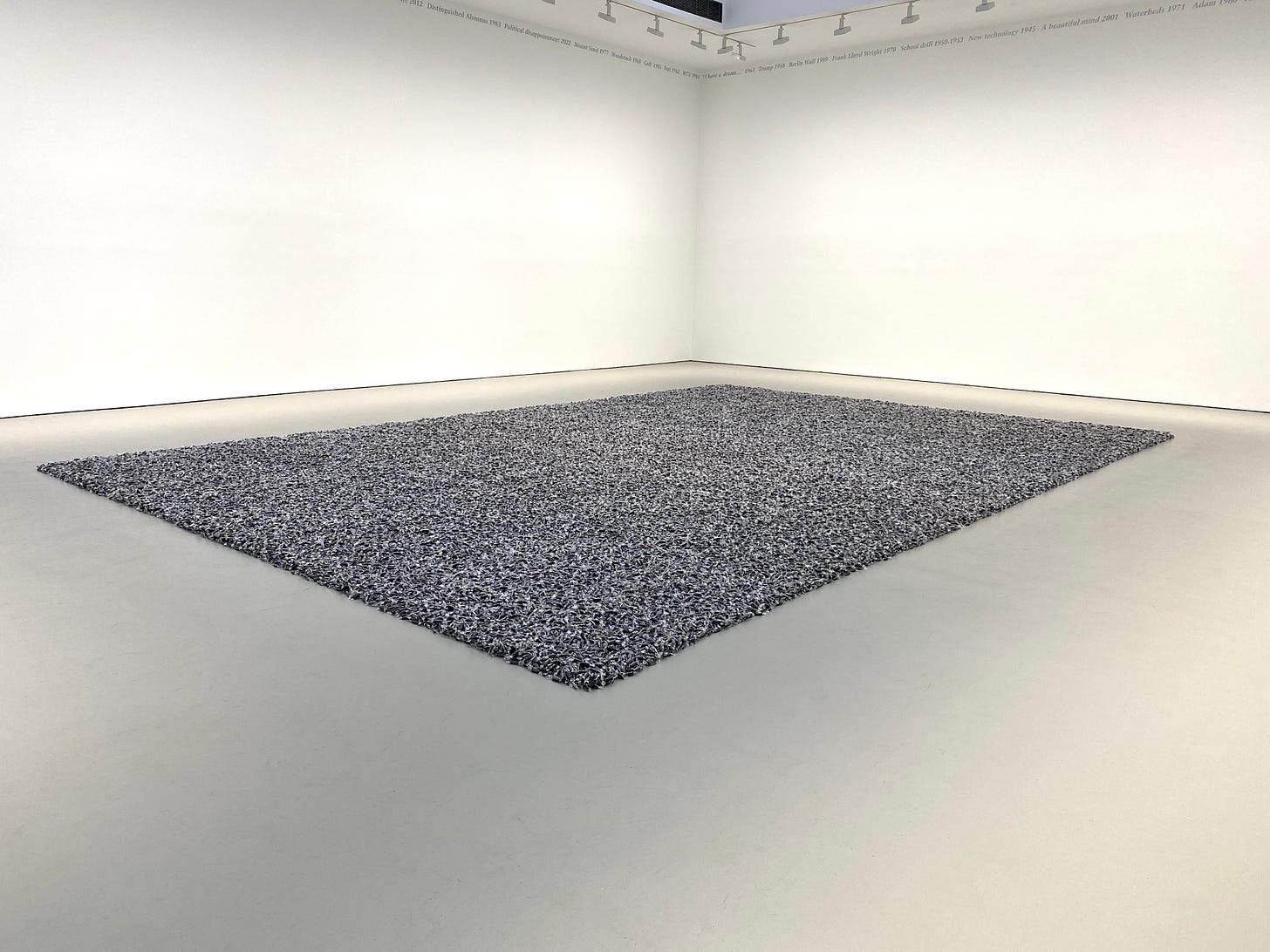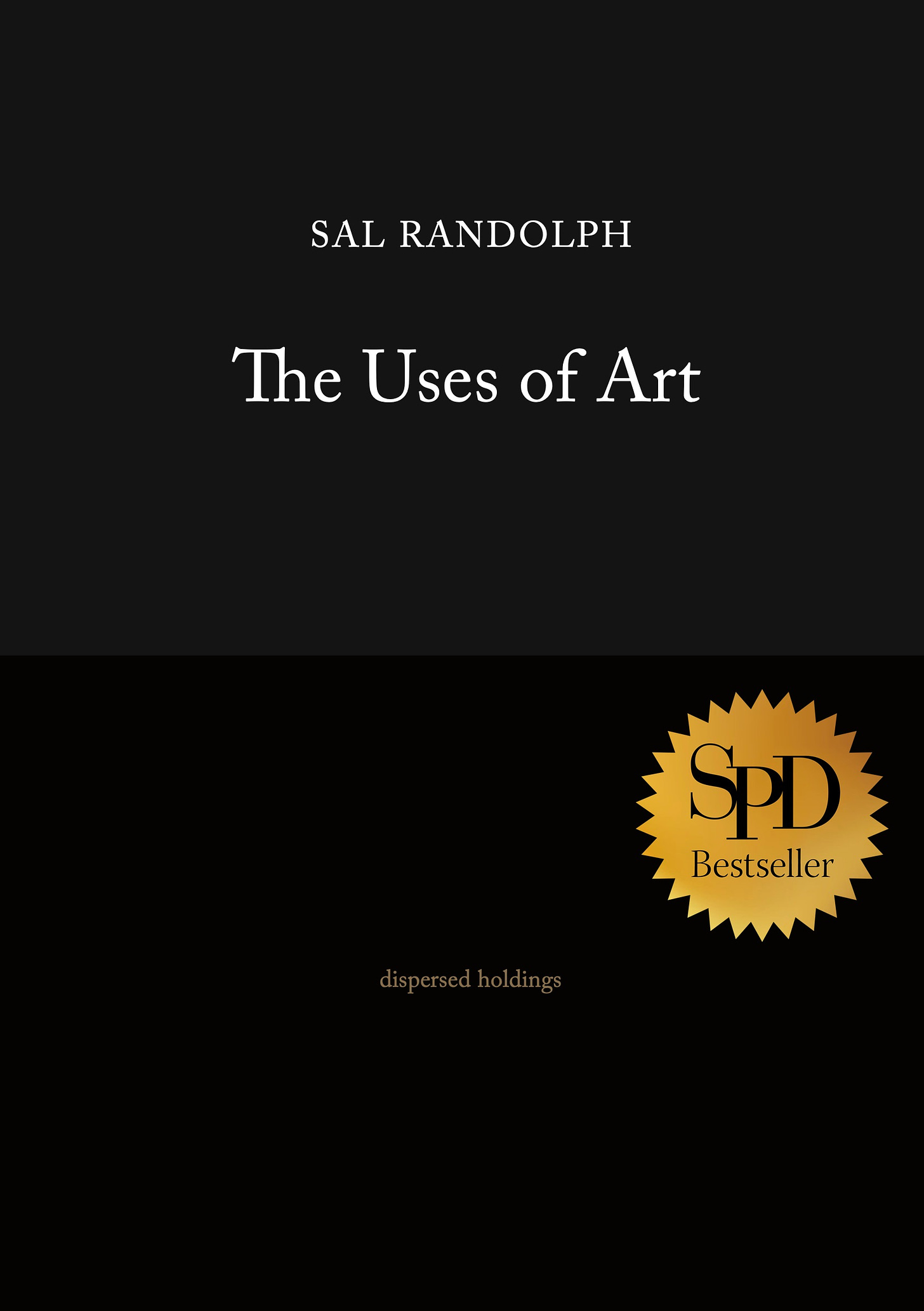The Taste of Public Opinion: Felix Gonzales Torres
Considering Felix Gonzales Torres and the work of art as a Zen koan.
Dear Friends,
For some time now I’ve been thinking of the relation between contemporary art and Zen Buddhism—this week I take up the question of whether we can approach works of art as koans and what that would mean for our experience of them.
You can watch a slightly different version of this essay—which I gave as a dharma talk for the Village Zendo this Sunday—on Youtube (link below).
Thanks again to all who have subscribed! Your subscriptions offer much encouragement to the writer.
—Sal
The Taste of Public Opinion
I’ve been mostly away from New York for the past couple of years, teaching at Bennington College in Vermont, and at the same time getting a degree. All of that finished at the end of December, and now I’m back in the city; one of the things I’ve been doing since I’ve been back is looking at art again.
I live in Chelsea, so the big galleries are right near me. I pass galleries with my dog on the way to the dog park. My dog actually has a favorite gallery, where she has fallen in love with one of the gallery attendants who sits at a desk near the big plate glass window. If I don’t want to stop while she looks longingly through the glass, we have to walk on the far side of the street.
So I’ve been thinking about art again, especially art from the position of someone who is just passing by and stopping in to see whatever’s there. I’m returned to one of my perennial questions: what’s the point? what’s all this for?
I make art and write about art, so presumably theres’s a way in which everything I see is relevant to me, but in another way I can have moments of almost complete astonishment that so much energy and time and money and real estate is put into exhibiting some particular painting. The whole enterprise can seem absurd.
What’s it all for?
The book I wrote was meant to answer this, but I still have the question. And in this way, it’s just like Zen. I could read or write a hundred books about Zen and still there is a space of unknowing. Fortunately, Zen accepts and welcomes that space of not knowing. “Not knowing is most intimate,” as the great Zen teacher Dongshan put it.
Which is to say, in part, that knowing isn’t the relationship one is meant to have with Zen or Zen practice. Knowing isn’t the relationship we’re meant to have with our own lives. And I think knowing is also not the relationship we are meant to have with art.
I’ve been thinking about the relation of my Zen practice and my art practice, and wondering what it would be like to treat works of art as if they were koans.
There are many ways in which koans are quite distinct from works of art. The word koan means “public case,” and they are indeed cases, or examples, of Zen teaching situations. They often record stories and dialogs of the great teachers from the golden age of Zen (known as Chan in Chinese) during the Tang dynasty.
Koans are an integral part of the Zen literature; they both embody and express the Zen teachings. In some sense, all koans are about the same thing: the dharma, or as I often like to think of it, reality. They are most commonly anecdotes of encounters between Zen teachers and their students, and often the subtext is that this particular encounter caused the student to realize something, to have a realization or a moment of enlightenment. Typically the responses are puzzling or confounding to the rational mind. Zen students study these stories as part of their training and practice.
Works of art, by contrast, come from all kinds of traditions and usually embody or express forms of experience that are personal and individual. They don’t come equipped with dharma points or Buddhist teachings.
What makes them similar might be what we do with them, the way we make use of them. When Zen students study koans, we don’t study them academically. Even though there are plenty of commentaries and dharma talks to turn to, ultimately these are not much help. What matters is our personal experience of the koan.
We take up the words of the koan and the story they tell as if they were a small object that we can turn and turn in our hands, seeing one angle then another. We do want to understand the historical meanings and context, but these exist as a kind of cloud around the koan itself. More important is the connection between the koan and our life right now. Maybe you step into the story and inhabit the various characters one by one. Maybe those characters come to life as people you know, or the story maps to a situation you are in.
The connections between the koan and your life are many, various, and everchanging. By holding up the koan in your mind, you give yourself a way to both consider the koan and consider your life.
One of my favorite koans is this: A monk asked Chao Chou, “what is the meaning of Bodhidharma coming from the west?” Chao Chou said, “the cypress tree in the garden.”
This question is a classic. Bodhidharma is the ancestor who was considered responsible for bringing what we now recognize as Zen practice from India to China. From the point of view of China, India is the west. It’s a way of asking “What is the meaning of Zen?” or “What is the point of all this?”
The cypress tree in the garden. The ginko tree outside your New York City window. The maple tree in your backyard. He doesn’t mean the object, the tree, but the object is also not irrelevant.
There are many other koans that have this structure, sometimes they ask the meaning of Bodhidharma coming from the west, sometimes they ask “What is Buddha?”
A monk asked Matsu, “what is Buddha?” He said, “mind is Buddha.” Another time he answered the same question, “no mind, no Buddha.”
A monk asked Dongshan, “what is Buddha?” He said, “three pounds of flax.” Some say he was measuring out flax at the time, and lifted up the bag he had in his hand, judging its weight and saying, “about three pounds.”
A monk asked Yunmen, “what is Buddha?” He said “a dried shit-stick” Yunmen was talking about the kind of stick that was used the way we use toilet paper.
So, imagine yourself for a moment with one of these koans. In some sense they are all saying the same thing, but in another sense they are very different. Certainly they are very different to practice with, to take in.
If you sit with the cypress tree, your mind will have associations to the cypress, or the oak, to trees, to the garden, to what is “right there” in that sort of way. You may be sitting in a place with a potted tree, you may look out your window at a tree, you may see some trees when you take a walk, or you may remember walking among trees. It will naturally be different if you sit with “three pounds of flax” or “a dried shit-stick.”
The question is the same, and the answer is the same, but it’s also true that each answer is different. Fresh and alive. Chao Chou said a cypress tree. Dongshan said flax. Yunmen said a shit stick. None of these answers is more right than the others.
One way to think of works of art is as if they were initiating a dialog like this one. The work of art asks a question, and by your response, by your experience, you offer an answer.
A couple of days ago I went to look at some art a few blocks from my house. In particular I wanted to see a show by the artist Felix Gonzalez-Torres.
Felix Gonzales-Torres was born in Cuba in 1957—a couple of years before I was born here in New York. He came to New York as a student, and studied art at the Whitney Independent Study Program, at Pratt, at the International Center of Photography, and at NYU. Which is all to say he was a an artist who was right in the center of things, in the center of the conversation about art which was going on in New York in the 80s. He was also a gay man, and found himself at the center of the AIDS crisis as well. In 1988 Felix’s lover Ross Laycock was diagnosed with AIDS; Ross died in 1991. Felix was also HIV positive, and died of AIDS-related causes in 1996.
I first saw his work when he had a big retrospective at the Guggenheim in 1995, a year before he died. One thing I was most struck by in the show were his stacks of posters. They looked like minimalist blocks, but made from sheets of paper. The idea was that anyone could take a sheet from the stack. I remember how terrifying and strange it felt to be in a museum and take something. I stood and watched other people do it, but I was frozen. Finally I did it. It felt like stealing. At the same time it felt like liberation. This was part of the power of his work, to make you experience the rules of the museum and the rules inside yourself. That one act of taking a piece of paper in a museum changed my work and my relation to art permanently.
He was also known for similar works made from candies. These are ordinary commercial candy, but a lot of it, piled in a heap or spread out on the floor. Like the stacks of paper, the idea was that anyone could take one.
There’s one especially moving candy piece that he made for his lover, Ross, in 1991, the year Ross died. It was a kind of portrait. The candy was in colored wrappers and the amount of candy on display was, at least ideally, 175 pounds, which was Ross’s weight. What does it mean, then, to take a candy from that pile?
Since then I’ve seen Felix Gonzalez-Torres’s work many times, and I’ve often collected posters and pieces of candy. Once I was even in a show that included one of the candy pieces. For years I had two of his posters up on my wall. One said, Somewhere better than this place and the other said Nowhere better than this place. I loved the way that one of them would seem optimistic and the other pessimistic, and then suddenly they would change places.
So, the other day, I went to David Zwirner’s 19th Street space to see the Felix Gonzalez-Torres show. These galleries are huge and powerful, like museums, and the works were staged very formally.
In one big room there was a large rectangle of candy laid out very precisely on the floor, black rods of licorice in clear wrappers. It was gorgeous and chilling; it shimmered and caught the light in scintillating ways; it dazzled the eye and confounded the mind. The work was made from something like 700 pounds of these black licorice hard candies and it was called “Untitled” (Public Opinion). I don’t know for a fact that the public opinion he was referring to was about AIDS, but it certainly felt that way.
I stood there looking at it. I walked around the edge. It seemed inexhaustible. like something I could just keep looking and looking at.
I knew this work, but suddenly, in this new place, everything felt different. It looked so very formal in that huge white room. I knew perfectly well that I could take a candy, and I wanted to, but I was frozen again. Everything in the situation said “don’t touch.” It actually went through my head that in this installation was a special case, that the era of taking candies was over, that Felix Gonzales-Torres’s work had achieved the kind of “museum status” that made it permanently untouchable.
I didn’t want to reach down. I just stood there a long time. Finally, I forced myself to do it. I actually waited until no one was in the room—I stepped out of the line of sight of some other people I could see through the entranceway. I took a candy. I quickly hid it in my pocket. Then I felt ridiculous and took it out again. I held it awkwardly.
As I walked out of the room I passed a woman who looked vaguely familiar. She unwrapped a candy and popped it into her mouth, glancing at me with a conspiratorial grin.
At other times, these candy works had seemed intimate and generous even as they were also provocative. This time, this piece, it felt like there was an invisible glass wall between the work and me, and that wall was made entirely of my own response to the situation. I could feel very directly how powerfully I had been socialized in my life. Invisible and unconscious rules of behavior outweighed what I actually knew rationally.
The next day I went back again. I had spent time thinking about the piece and sorted through my feelings a bit. I laughed at how constrained I had felt. I knew better! So this time I knew I would take a candy and just eat it. And I did.
I don’t like licorice, but I took a candy, unwrapped it, and put it in my mouth.
The bitter flavor of the licorice flooded my tongue, herbal and astringent. I grimaced and squinted. After the first shock of licorice faded, there was a wave of intense over-the-top sweetness. It seemed to me it tasted exactly like public opinion.
I went into another room and paged through one of the catalogs they had, sucking on the candy, forgetting the candy. And then I noticed that just a very thin cylindrical rod was left in my mouth, and then a sliver, fragile, and then the sliver broke apart on my tongue until it was just a lingering, cloying, sensation.
As I left the gallery, I put my hand in my pocket and there was the wrapper. To my fingers it just felt like a bit of trash, and in a way it was.
What is the meaning of Bodhidharma coming from the west? What is Buddha? What is art, what is AIDS, what is dying, what is public opinion?
A licorice candy dissolving in my mouth.
Felix Gonzalez-Torres is on view at David Zwirner Gallery through February 25, 2023.
You can watch a slightly different version of this essay here:
Further adventures and new ways of seeing can be found in my book, The Uses of Art.
Artist Sal Randolph’s THE USES OF ART is a memoir of transformative encounters with works of art, inviting readers into new methods of looking that are both liberating and emboldening.
Dazzlingly original, ferociously intelligent.
— Michael Cunningham
A joyful, dazzling treasure-box of a book.
— Bonnie Friedman
Here’s a guide, to waking up, over and over again.
— Roshi Pat Enkyo O’Hara








So beautiful- and mind- blowing. I just listened to your video. It is so powerful - this art by Torres and your poetry of it ( your speaking it in deep words) that it passes from him, ( we could say through him too) through you to me- and transforms me. It does its work on me. It changes me - to attend to the moment of life, the moment of confinement and reaching and moving thru and past it, the shedding of our mortal coil, the shedding of our self. Oh my and the flight and release that comes from that. Oh my. The best words I can say for something that cannot be spoken. Thank you for sharing.
Love this. I will not be able to un/frame/feel/think/ the notion that a work of art - any and all - can be a koan, just like a tree and a shit stick can. And what that promises - if I truly treat artworks as shitsticks to consider, and trees to consider, I can stop asking them to stand still (answering, telling, flirting, spitting, waving, winking, wheedling, etc) and instead view them as shimmering shares & flickering questions for all of us.
Or something,
Or/and not.